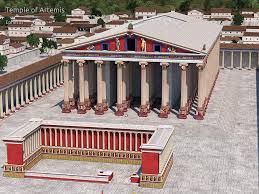Introduction
The Temple of Artemis at Ephesus, furthermore referred to as the Artemision, stands as one of the maximum illustrious and iconic monuments of antiquity. Revered as one of the Seven Wonders of the Warmed-over World, this grand temple changed into defended to Artemis, the Greek goddess of the quest, desolate tract, fertility, and childbirth. Located within the warmed-over municipality of Ephesus (close to the modern metropolis of Selçuk in Turkey), the temple changed into an increasing number of than a non secular shape—it changed into a testament to the cultural, architectural, and originative achievements of the warmed-over Greeks and a component-manner of worship that drew pilgrims, tourists, and investors from wideness the Mediterranean global.
Despite its cutting-edge nation of ruin, the Temple of Artemis maintains to capture the creativeness of historians, archaeologists, and tourists alike. This vendible explores the temple’s origins, production, non secular significance, architectural features, destruction and reconstruction, rediscovery, and its legacy as a global marvel.
Historical Context of Ephesus
The Municipality of Ephesus
Ephesus, an warmed-over Ionian municipality placed at the western tailspin of Asia Minor, changed into one of the most essential urban facilities of the classical world. Its strategic position close to the Aegean Sea made it a thriving hub for exchange and way of life. Founded with the useful resource of Greek colonists inside the 10th century BCE, Ephesus short grew proper into a rich town, famed for its grand public homes, non secular temples, and vibrant marketplaces.
The Rise of Artemis Worship
Before the inrush of the Greeks, the location as soon as had a way of lifestyles of goddess worship, likely related to fertility cults of Anatolian beginning. When the Greeks arrived, they assimilated the close by deity with their own goddess Artemis, developing a unique syncretic figure. This hybrid Artemis, though much like the Greek goddess, took on factors of a fertility goddess, often depicted with multiple breasts, symbolizing her nurturing powers.
Construction of the Temple
The First Temple
The primeval regarded temple defended to Artemis turned into synthetic truely 800 BCE. Built of perishable substances like timber and clay, it served as a simple shrine. As the reputation and wealth of Ephesus grew, so did the targets for a increasingly more surprising temple.
The Second Temple (circa 550 BCE)
The an increasing number of well-known and monumental version of the Temple of Artemis changed into initiated without a doubt 550 BCE underneath the Lydian king Croesus, regarded for his tremendous wealth. Designed by using the Greek architects Chersiphron and his son Metagenes, the temple took over a century to well-constructed and have become one in every of the biggest structures inside the Greek global.
Dimensions and Materials
The temple was outsized in scale—measuring approximately one hundred fifteen meters (377 feet) in length and fifty five meters (one hundred eighty ft) in width, with over 100 marble columns status 18 meters (60 toes) tall. Built entirely of marble, it covered a raised platform, a double colonnade, and richly ornate sculptures by way of a number of the finest artists of the generation, including Scopas of Paros.
Architectural and artistic talent
Lonic orders and design
The temple of Artemis became an early and influential example of ionic structure. It emphasized a deputy plan (a dual line of the column) and symmetry, beauty and decorative details. A mixture of exceptional marble and sculpture relief in shape noted the ionian taste for exciting purification.
Statues and decorations
The temple was widely published with fries, pedcents, and mythological scenes, floral motifs and opening of opening hideouts. One of the maximum striking characteristics was the statue of Artemis placed inside the sanctuary. Unlike the same chronic Greek illustration, this artemis wore an ornate dressed dressed with animals and many breasts, symbolizing her position as a reproductive goddess.
Artistic contribution
Some of the maximum family Greek sculptors and craftsmen are unresolved for the decoration of the temple. Pliny the Elder, The Roman Historian, Private that the Temple Changed into a Collaborative Work of the Greatest Artists of the Time, which remoter Multiplied its status.
Religious Significance
The Cult of Artemis
Artemis changed into the most crucial deity of Ephesus. The temple served as her primary sanctuary and the religious component-manner of the city. Her worship included rituals, festivals, sacrifices, and services. Pilgrims traveled from afar lands to are trying to find her benefits for fertility, safety in childbirth, and unscratched travels.
The Artemisia Festival
One of the essential events turned into the Artemisia, a grand festival held in her honor. It covered processions, tune, robust contests, and spiritual ceremonies. The festival helped to enhance the metropolis’s spiritual prominence and attracted visitors from everywhere in the Hellenic international.
The Temple as a Financial Institution
Besides its non secular function, the Temple of Artemis furthermore served as a steady treasury. Its wealth and influence made it a trusted place for storing valuables, vicarial like a wall for merchants and kings alike.
Destruction and Rebuilding
Arson via Herostratus (356 BCE)
In a notorious incident, the temple become set properly-lit in 356 BCE via a man named Herostratus, who sought reputation via destruction. Ironically, his name has survived via the a while, rhadamanthine synonymous with repute-looking for vandalism. The fire destroyed a great deal of the temple, however it furthermore paved the way for a an increasing number of incredible reconstruction.
Rebuilding the Temple (Post-356 BCE)
Soon without the hearth, the human beings of Ephesus started out rebuilding the temple on an plane grander scale. Contributions came from in the course of the Greek global, such as from Alexander the Great. Though his offer to finance the temple became declined diplomatically, the reconstruction moved forward and became finished in the Hellenistic period.
Later Decline
The temple’s importance began to wane under Roman rule. While it remained a tourist witchery and maintained a few non secular functions, the rise of Christianity led to the suppression of pagan cults. Eventually, the temple turned into closed, plundered for its marble, and fell into destroy.
Rediscovery and Excavation
Archaeological Discovery
For centuries, the phrase-for-phrase region of the Temple of Artemis remained unknown. In the nineteenth century, British archaeologist John Turtle Wood undertook a series of excavations underneath the auspices of the British Museum. After years of attempt, he determined the temple’s foundations in 1869.
Findings and Artifacts
Excavations discovered fragments of columns, sculptures, cash, and inscriptions. Many of these artifacts were shipped to the British Museum, wherein they stay today. The web page itself now consists of a single reconstructed column, symbolizing the temple’s former grandeur.
Cultural Impact and Legacy
As a Wonder of the Warmed-over World
The Temple of Artemis turned into inscribed as one of the Seven Wonders of the Warmed-over World via warmed-over writers like Antipater of Sidon. Its sheer length, originative excellent, and architectural ingenuity secured its region at the listing. Unlike other wonders that targeted on engineering feats or military prowess, the Artemision become a triumph of beauty, divinity, and tradition.
Influence on Later Architecture
The temple prompted classical and Hellenistic architecture, in particular within the use of Ionic columns and temple layouts. It served as a model for later Roman temples and plane stimulated elements of Renaissance structure.
Symbol of Feminine Power
As a temple devoted to a powerful sexuality deity, the Artemision stood as a cultural symbol of the divine female. It emphasized the societal position of ladies in non secular and communal lifestyles in methods that were often singular for warmed-over Greek cities.
Mythology and Symbolism
Artemis in Greek Mythology
Artemis turned into the daughter of Zeus and Leto, and twin sister to Apollo. Associated with the moon, looking, virginity, and protector of young ladies, Artemis represented a ramified set of values. The Ephesian Artemis, but, diverged from the classical photo and incorporated neighborhood Anatolian and fertility goddess trends.
Symbolic Features
The a couple of-breasted statue of Artemis stays one of the maximum mentioned elements of the temple. Scholars interpret it as a fertility symbol, though some oppose the bulges constitute manful testicles or gourds presented as tribute. Regardless, the statue represents zillions and safety
The Temple in Modern Imagination
Literature and Art
The Temple of Artemis has stimulated myriad works of literature, portray, and scholarly take a look at. Poets and historians from protohistory to fashionable times have extolled its eyeful and mourned its loss.
Tourism and Pilgrimage
Though only a unmarried post stays standing, the temple website online continues to vamp visitors. Tourists explore close by Ephesus, one of the maximum properly-preserved warmed-over cities, even as imagining the beauty of the temple that after dominated the panorama.
Conclusion
The Temple of Artemis at Ephesus become increasingly more than an area of worship—it was a masterpiece of warmed-over engineering, a hub of spiritual lifestyles, a image of societal satisfaction, and a steer of cultural brilliance. As one of the Seven Wonders of the Warmed-over World, it reminds us of humanity’s rememberable quest for splendor, spirituality, and legacy.
Though time has decreased the unconfined temple to ruins, its tale remains vividly alive. In its ruins lie the echoes of prayers, the footsteps of pilgrims, the chisel marks of grasp sculptors, and the aspirations of a civilization that sought to touch the divine thru stone and spirit.


